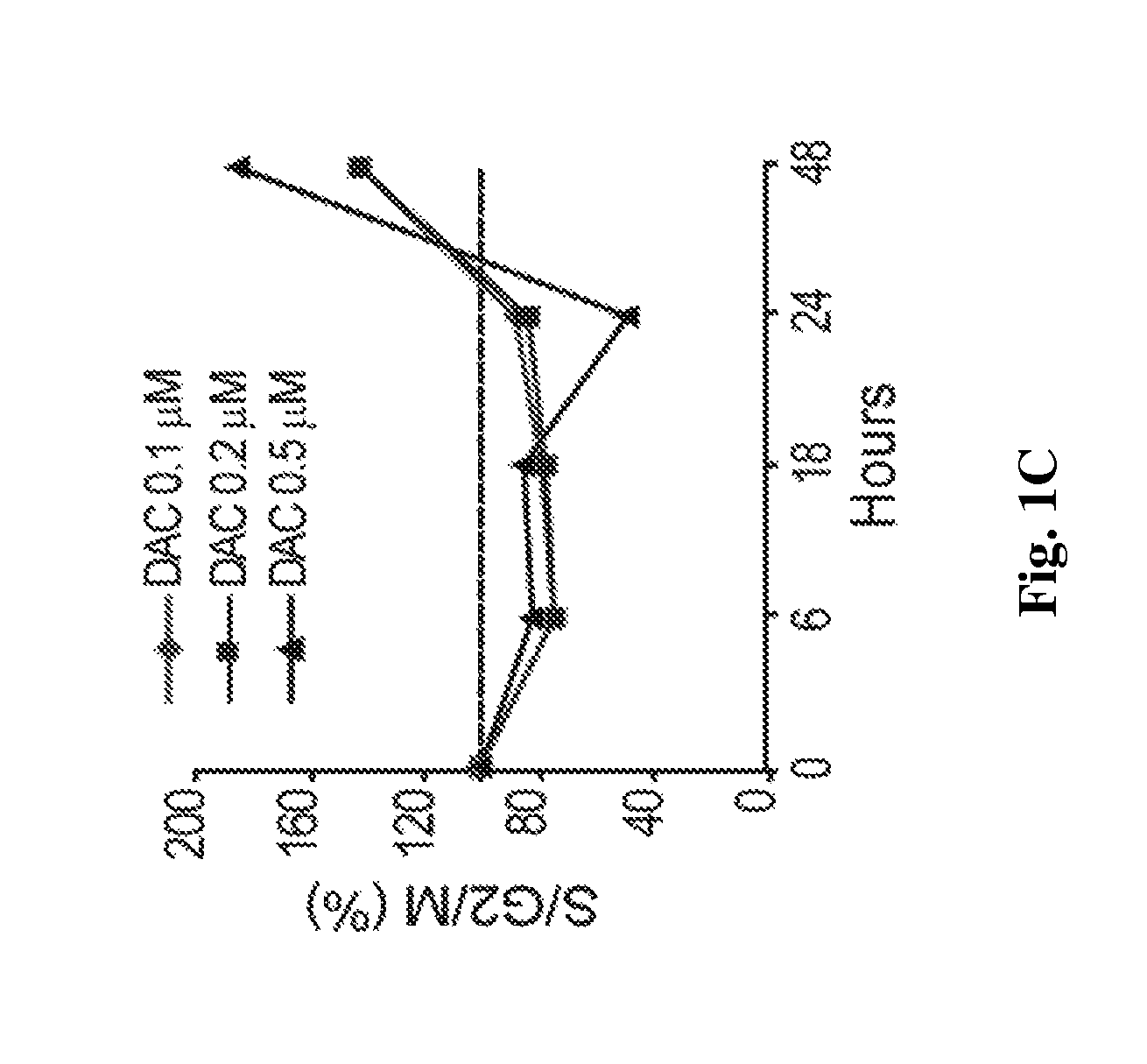Compositions comprising decitabine and tetrahydrouridine and uses thereof
a technology of tetrahydrouridine and decitabine, which is applied in the direction of drug compositions, biocides, extracellular fluid disorders, etc., can solve the problems that the clinical or experimental application has not been optimized for the depletion of dnmt1, anti-metabolite effects that kill cells are undesirable, and achieve the effects of increasing the self-renewal of normal stem cells, preventing cell division, and induring terminal differentiation and apoptosis
- Summary
- Abstract
- Description
- Claims
- Application Information
AI Technical Summary
Benefits of technology
Problems solved by technology
Method used
Image
Examples
example 1
Decitabine can Deplete DNMT1 in Normal Hematopoietic Stem and Progenitor Cells without Causing Measurable DNA Damage or Apoptosis
[0108]Decitabine is shown herein to deplete DNMT1 without causing measurable DNA damage. Decitabine at a concentration of 0.2-0.5 μM depletes DNMT1 in normal hematopoietic precursor cells (data not shown). Normal CD34+ hematopoietic precursor cells were isolated from cord-blood. A Q-dot based immunofluorescence assay quantifies DNMT1 depletion by various doses of decitabine. Q-dot conjugated 2° ab against anti-DNMT1 1° ab allows quantification of DNMT1 depletion in normal human CD34+ hematopoietic cells exposed to various levels of decitabine. DNMT1 was quantified in 500 cells for each treatment condition. DAPI was used to stain the nuclei Image-quant software is used to quantify the DNMT1 by the Mean Intensity Fluorescence (MIF) variable. Decitabine levels were assessed in μM.
[0109]FIGS. 1A and B) Decitabine at a concentration of 0.5 μM, added to normal h...
example 2
DNMT1-Depleting but Non-DNA Damaging, Doses of Decitabine have Opposite Effects on Normal Stem-Cells (HSC) Versus Leukemia Cells
[0114]CD34 cells transduced with AML1-ETO recapitulated some features of leukemia stem-cells (LSC) (impaired differentiation and increased self-renewal) and represented a first-hit or early model of leukemic transformation. The Kasumi-1 cell-line is derived from a patient with AML1-ETO leukemia and represents a late-stage model of transformation and malignant evolution. Both of these models terminally differentiate with non-DNA-damaging but DNMT1-depleting doses of decitabine. FIG. 2A) Cell counts: an ideal therapeutic index was seen, with proliferation of normal cells while leukemia cells decline. In contrast, standard therapy (Ara-C), given at equimolar doses was more devastating to normal cells. Normal cells retained primitive morphology with decitabine treatment (data not shown). In contrast, CD34 AML1-ETO and Kasumi-1 cells morphologically differentiat...
example 3
DNMT1 Depletion without DNA Damage Produces Terminal Differentiation (not Immediate Apoptosis) of Primary Leukemia Cells from Patients
[0115]Primary leukemia cells obtained from bone marrow or peripheral blood (with informed consent on an IRB approved protocol) were cultured in media supplemented with cytokines with or without decitabine 0.5 μM added 2× / week. These concentrations of decitabine did not cause DNA damage or immediate apoptosis. FIG. 3A) The samples were obtained from a spectrum of AML sub-types. FIG. 3B) Cell counts at D7 in untreated control versus decitabine-treated cells. Giemsa staining demonstrated terminal myelomonocytic differentiation of decitabine treated cells in 12 of 14 cases (data not shown). In cases of resistance, DNMT1 expression in the cells was retained, indicating failure of decitabine activity, rather than resistance to the effects of DNMT1 depletion (data not shown).
[0116]Decitabine 0.5 μM, concentrations that did not cause early apoptosis as measur...
PUM
| Property | Measurement | Unit |
|---|---|---|
| concentration | aaaaa | aaaaa |
| concentration | aaaaa | aaaaa |
| composition | aaaaa | aaaaa |
Abstract
Description
Claims
Application Information
 Login to View More
Login to View More - R&D
- Intellectual Property
- Life Sciences
- Materials
- Tech Scout
- Unparalleled Data Quality
- Higher Quality Content
- 60% Fewer Hallucinations
Browse by: Latest US Patents, China's latest patents, Technical Efficacy Thesaurus, Application Domain, Technology Topic, Popular Technical Reports.
© 2025 PatSnap. All rights reserved.Legal|Privacy policy|Modern Slavery Act Transparency Statement|Sitemap|About US| Contact US: help@patsnap.com



